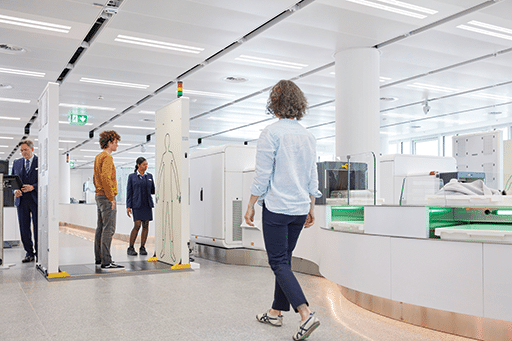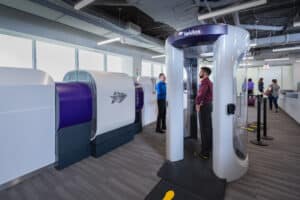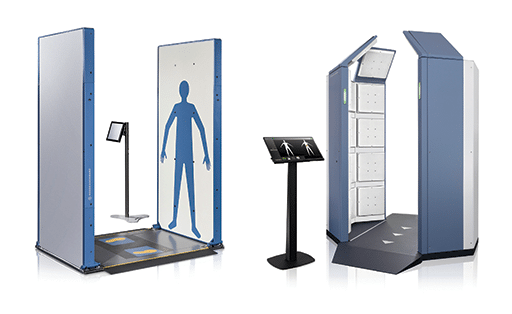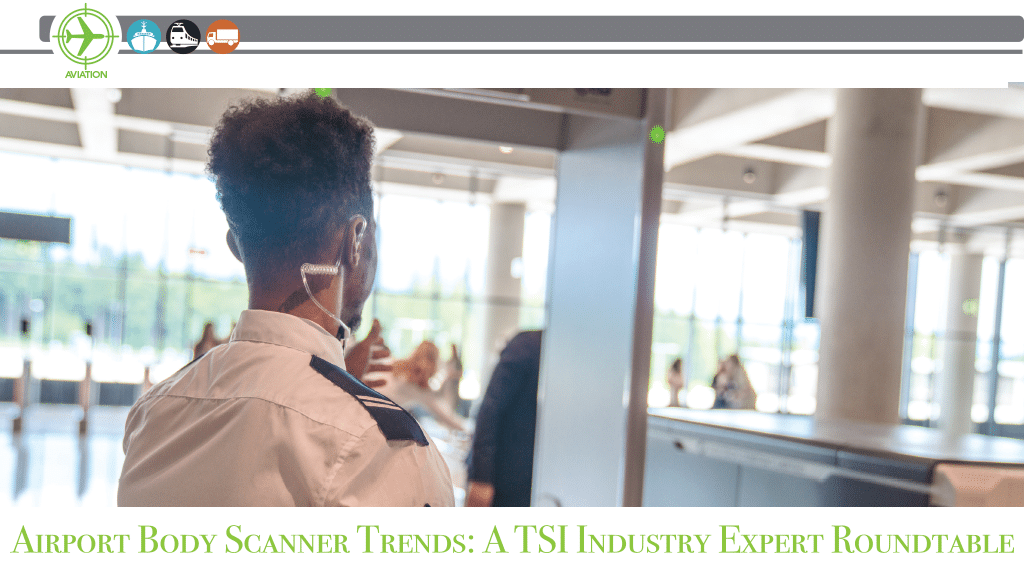According to a January 12, 2024, news release issued by the U.S. Transportation Security Administration, this agency screened a record 858+ million passengers in 2023. Although the TSA news release doesn’t say it directly, it is reasonable to assume that most or likely all these people were checked using body scanners for concealed weapons and contraband. These screenings prevented 6,737 firearms — 93% of them loaded — from getting into the secure areas of the airports and onboard aircraft.
Clearly, airport body scanners are more important than ever for keeping the world’s airports and airliners safe. This is why knowing the trends driving this technology today and into the future is so important for this in the aviation industry.
To get a handle on these trends, TSI magazine staged a ‘virtual roundtable’ with three experts with major body scanner manufacturers. They are Nik Karnik, vice president and division manager at Leidos; Harald Jentsch, head of Aviation Security Screening for Rohde & Schwarz; and Rob Keeler, managing director of LINEV Systems UK. Here is what the experts had to tell us.
TSI: How have airport body scanners evolved and improved over the years?
Nik Karnik: As the provider of the first millimeter wave people scanner over 20 years ago, Leidos keeps continuous improvement in passenger screening a top priority. Today, airports expect high throughput and effective threat detection with better accuracy across a broad range of metallic and non-metallics. They also want minimal false positives to reduce the frequency of secondary pat-downs and intervention by security personnel.
To keep up with evolving threats and customer needs, our newest system has moved away from traditional detection methods based on image similarity and features extracted by human intuition. We employ deep learning-based, artificial intelligence algorithms that utilize gender-neutral threat detection. Additionally, our advancements in dataset generation ensures that these algorithms are built using high quality imagery with precise threat labeling, reducing the ambiguity between true threats and non-threats.
Harald Jentsch: Security scanners have evolved significantly over the last decade, largely driven by advancements in artificial intelligence and machine learning technologies. Previously, checkpoint security screening relied heavily on X-ray scanners for baggage and walk-through metal detectors as well as physical pat-downs for people screening. Limited to the detection of concealed metallic items, it wasn’t possible to detect person-borne concealed explosives, ceramic knives, printed weapons, or contraband.
This changed with the introduction of millimeter wave (mmW) security scanners more than 15 years ago, which detect a far wider range of threats and prohibited items. Another change from legacy body scanners is the physical design of the R&S QPS201 Ultra High-Definition (UHD) body scanner. The system has an open design and is fully electronic — comprised of two solid-state flat panels. This means on-person security screening is no longer confined to a narrow cylindrical scanner and is made more comfortable with an easy hands-down scan pose. Further, the QPS201’s large, open pathway is an accessible path for passengers with disabilities and provides additional egress for emergency evacuation situations.
Rob Keeler: The evolution of airport body scanners has been a fascinating journey marked by technological advancements tailored to address emerging security threats in the realm of aviation.
Initially, aviation security measures were minimal as threats were virtually nonexistent in the 1950s. However, with the rise of terrorist hijackings involving metallic weapons such as guns and knives, passenger screening became imperative.
The response to these threats led to the development of Walk-Through Metal Detectors (WTMD) and Handheld Metal Detectors (HHMD), serving as the primary screening tools for person-borne threats for years. While effective against metallic threats, these detectors proved insufficient against non-metallic threats, highlighted by incidents like the attempted bombing by the “underpants bomber.”
To overcome the limitations of WTMD, exploration into new technologies capable of detecting both metallic and non-metallic threats ensued. Initial trials involved Backscatter X-ray Body Scanners, showing promise in detecting metallic and non-metallic items on a person’s body but were unable to identify internal threats. However, concerns regarding ionizing radiation’s potential health hazards led to their removal from use at Manchester Airport.
Subsequently, investment shifted towards the development of alternative technologies, notably active millimeter wave (mm-wave) scanners. These scanners, currently deployed in airports, offer robust detection capabilities. Nonetheless, as the threat landscape evolves, future advancements will likely be necessary to address new techniques that may evade existing detection methods.
TSI: Why are backscatter x-ray units being replaced by millimeter wave scanners?
Jentsch: Body scanners, utilizing backscatter or transmission X-ray technologies, have been replaced by mmW-based scanners in aviation security screening, and many other use cases due to safety and privacy concerns. Millimeter wave imaging has advanced significantly and delivers safe and accurate people screening and as millimeter waves cannot penetrate skin, scanners like those produced by Rohde & Schwarz pose no health risks to travelers and security operators
Keeler: The replacement of backscatter X-ray units by millimeter wave scanners stems from a confluence of factors encompassing privacy concerns, fears surrounding ionizing radiation, and the acceptable detection efficacy offered by millimeter wave technology.
Initially, privacy issues hindered the widespread adoption of backscatter X-ray scanners. However, the subsequent apprehension regarding ionizing radiation further sidelined X-ray technology.
Regulations governing the use of ionizing radiation, such as Euratom, IRR17, and JOPA2004, are predicated on the Linear No Threshold (LNT) model, which asserts that any exposure to radiation carries inherent health risks. Consequently, X-ray systems encounter stringent limitations unless their deployment can be justified by a significant probability of threat detection.
Despite emerging evidence supporting hormesis — the notion that low doses of ionizing radiation may confer health benefits — entrenched fears perpetuated by the LNT model continue to influence regulatory frameworks. This dichotomy underscores a complex interplay between scientific understanding and regulatory policy within the realm of radiation safety.
Given the low likelihood of encountering terrorists during routine passenger screenings, the adoption of millimeter wave scanners, which operate without ionizing radiation, has become the preferred choice. These scanners offer detection capabilities while circumventing the regulatory constraints associated with X-ray technology.
It is noteworthy that X-ray Transmission Body Scanners persist in certain contexts, such as customs inspections and prison facilities, where there is a reasonable probability of detecting internal threats such as drug smuggling. In such instances, regulatory justifications for X-ray system usage have been granted under specific frameworks, such as JOPA2004.
In conclusion, the transition from backscatter X-ray units to millimeter wave scanners reflects a multifaceted interplay between technological capabilities, regulatory considerations, and evolving perceptions of radiation risk. This shift underscores the dynamic nature of aviation security measures and the imperative of balancing efficacy with safety and privacy concerns.

TSI: What role can technologies such as AI play in making airport body scanning more accurate and efficient?
Jentsch: Artificial Intelligence (AI) and other methods are being used to enhance accuracy and efficiency in all security screening technologies. But AI and other advanced methods are only as good as the quality and quantity of data collected and processed by a security scanner.
The internal resolution of a body and its data quality are critical elements to enable AI delivery of performance improvements. In this way, AI-powered automated threat recognition (ATR) software enables the automated detection of person-borne threats and anomalies more effectively than ever to deliver reduced false positives and improved detection rates. These AI algorithms can be trained to recognize a wide range of current and emerging threats to improve security and enhance checkpoint throughput and operational efficiency of people-screening technology in aviation security.
In addition, AI has enabled the development of new capabilities to make screening more inclusive and easier for more passengers, as it has made it possible to implement gender nonbinary screening and enhanced detection performance powered by AI, making screening more accurate and faster for all passengers. Future enhancements that AI technology may deliver include the ability to make screening of passengers with disabilities less invasive and may someday be able to screen passengers in wheelchairs.
Keeler: The integration of AI into airport body scanning holds immense promise for enhancing accuracy and efficiency, yet it also presents challenges that must be navigated judiciously.
AI-based technologies excel in scenarios where detection tasks are well-defined, and threats can be clearly classified and marked during training. This is particularly advantageous in scenarios such as scanning for assembled firearms in non-dense baggage. However, challenges arise when dealing with disassembled weapons or when scanning for a wide range of potential threats simultaneously where the AI has not been ‘trained’ for those threats. The false alarm rate becomes a critical factor in determining the efficacy of machine vision, with low false alarms and high detection probability being prerequisites for its practical application.
In the context of body inspection, AI offers significant advantages, especially in conjunction with transmission X-ray technology. The relatively uniform nature of the human body simplifies the task for AI algorithms, particularly in discerning between biological structures and potential threats. By focusing on identifying non-human objects on the body, AI can streamline the inspection process, allowing operators to concentrate on anomalies rather than conducting exhaustive internal body analyses. While training operators to interpret complex biological structures can be challenging, machine vision simplifies this task significantly.
However, the integration of AI into security screening processes is not without its pitfalls. Operators may become overly reliant on AI, assuming that the absence of an alarm indicates the absence of threats. Yet, AI systems have inherent limitations, primarily dictated by the parameters of their training data. If an AI model is not trained to identify specific threats, it may fail to trigger an alarm even in the presence of a threat. This potential for oversight underscores the importance of incorporating complementary techniques such as Threat Incident Projection (TIP) to mitigate operator complacency.
In conclusion, while AI holds immense potential for revolutionizing airport body scanning, its implementation must be approached with caution. By leveraging its strengths in detecting predefined objects and complementing it with strategies to mitigate human error, AI can indeed enhance security screening efficiency and accuracy. However, careful consideration of its limitations and potential risks is imperative to ensure its integration yields positive outcomes in the realm of aviation security.
TSI: Can technology reduce the number of people needed for security screening work, at a time when help is hard to find?
Jentsch: Technology can indeed reduce the number of staff required in security screening operations. Advanced automated detection software can remove much of the burden from security operators by reducing false and nuisance alarms. This results in a higher pass-rate which reduces time-consuming alarm resolution pat-down procedures.
Fewer alarms mean fewer staff are required to resolve alarms. Beyond increased security and operational efficiencies, advanced technology also improves the passenger checkpoint security screening experience. Additionally, as part of the DHS Screening at Speed (SaS) Program, Rohde & Schwarz and its partners have developed technology that can automate and deliver self-service security screening. It utilizes the QPS201 with a passenger guidance system and access control gating solution, requiring minimal security staff to mainly provide direction and if required, to resolve alarms. As widely reported in major media coverage this month, this solution has been deployed at Harry Reid Las Vegas International Airport at the Transportation Security Administration’s (TSA) Innovation Checkpoint for a six-month ongoing trial assessment. It was reported that this demonstration system can substantially reduce the number of screening operators from twelve people down to five for these trials.
Keeler: The role of technology in reducing the number of personnel required for security screening work, particularly during times of scarcity, is a multifaceted consideration influenced by task complexity and the efficacy of technological solutions.

While technology, particularly AI, holds promise in streamlining security screening processes, its implementation hinges on the complexity of the task at hand. AI’s effectiveness is most pronounced when tasked with aspects of the screening process where it can deliver close to 100% probability results with a negligible false alarm rate. This doesn’t necessarily translate to a reduction in personnel numbers but rather a refinement in the qualifications required. AI can effectively guide operators, simplifying their tasks and enhancing overall efficiency. However, it’s premature to rely solely on machine vision algorithms given current technological limitations.
Beyond mere reductions in staffing, the crux lies in technology’s potential to enhance the Probability of Detection (PoD) of threat items. Irrespective of the workforce size, certain threats may evade detection through manual searches, particularly those concealed internally.
A system boasting a high PoD could indeed lead to a significant reduction in staffing requirements. However, this must be balanced with the risk of a heightened False Alarm Rate (FAR), wherein alarms are triggered for non-threatening items. Striking this balance is critical, often requiring optimization of the Receiver Operating Curve (ROC) to find equilibrium between PoD and FAR.
The impact of technology on staffing levels is palpable in people screening, where technologies such as millimeter-wave body scanners play a pivotal role. Depending on the FAR required to achieve an acceptable PoD, the need for manual pat-downs may vary. High FAR scenarios may necessitate numerous manual pat-downs, potentially escalating staffing requirements, especially considering same-sex pat-down protocols. Conversely, a low FAR at the requisite PoD could effectively reduce the demand for personnel.
In conclusion, while technology presents opportunities to enhance security screening efficiency and reduce staffing requirements, its implementation must be carefully calibrated to balance PoD and FAR considerations. Achieving this equilibrium is crucial to optimizing security screening processes in the face of staffing challenges.

TSI: What other trends are affecting the airport body scanner market, in terms of products and client needs?
Karnik: We expect to see automated, self-screening checkpoints more prevalent in the future. This requires body scanners to be not only accurate and fast, but easy for even the casual traveler to use. These checkpoints will also need enterprise software to enable and aid remote monitoring. With a holistic management solution, capable of integrating screening technologies across manufacturers, airports will have access to vital security data within a single interface. This could include everything from traveler verification data and flight data to the data collected from people and baggage scanners.
Jentsch: As passenger volumes continue to increase at airports around the world and as airport security staffing remains challenged, the airport body scanner market is being driven by the need for faster, more efficient and minimally intrusive security screening for all passengers.
In addition, technology needs to adapt to process a diverse range of passengers. The number of aging and disabled travelers is growing and there is the opportunity, with new technology, to make security screening easier and faster for all travelers.
Working with a wide range of our customers, we are being called upon to optimize the R&S QPS systems’ screening capability for specific use cases. At Rohde & Schwarz we are able to develop specialty software to adapt, both the R&S QPS201 and the R&S QPSWALK scanning software, for specific use cases to, for example, facilitate airport employee screening and enable other high-volume security screening operations.
Keeler: The airport body scanner market is undergoing significant shifts influenced by a multitude of factors ranging from technological advancements to evolving client needs and regulatory standards.
On the technological front, the prevalence of airport security procedures presents challenges in terms of efficiency and efficacy. While some airports still rely on traditional metal detectors, many have adopted state-of-the-art millimeter-wave scanners, which are increasingly becoming the preferred choice due to their superior detection capabilities when compared to metal detectors. Moreover, there’s a growing trend towards non-stop inspection procedures, streamlining the scanning process to minimize delays and queues, akin to passing through a metal detector seamlessly.
However, mm-wave scanners have limitations, particularly in their inability to provide internal imaging. This shortfall has paved the way for the potential resurgence of transmission X-ray body scanners, particularly those employing ultra-low doses of radiation. The legality of such scanners is a critical consideration, with regulatory standards like ANSI 43.17-2009 governing radiation safety in the United States. While some countries have stringent regulations against X-ray usage, advancements in technology and safety measures may pave the way for broader acceptance.
Moreover, the dynamic nature of aviation security demands equipment capable of addressing both existing and emerging threats. Suppliers are thus focused on enhancing the Probability of Detection (PoD) while reducing the False Alarm Rate (FAR) and streamlining scan duration to enhance throughput and passenger experience.
In essence, the future of airport body scanning lies in striking a delicate balance between technological innovation, regulatory compliance, and addressing evolving security threats. Advancements in AI, coupled with improvements in scanning technology, hold the promise of revolutionizing airport security, ensuring the safety and efficiency of air travel for passengers worldwide.
TSI: What body scanning products are you offering that address these trends and needs?
Jentsch: Unlike legacy body scanners, Rohde & Schwarz has developed on-person screening technology specifically to meet the needs of modern security screening operations. Both of our solutions utilize safe, high-definition mmW technology and both of our products utilize sophisticated AI and machine learning to continually improve the detection performance for increased throughput and improved passenger experience.
Our flagship solution, the R&S QPS201 Ultra High Definition (UHD) scanner, is widely deployed world-wide and has redefined the standard for on-person screening. The R&S QPS Walk2000 is our newest product in security scanners and utilizes ultra-wideband technology to deliver unmatched high-fidelity screening without the need for passengers and/or airport or other employees to divest outerwear and other clothing. The scanner screens continuously, without the need to stop, as required in typical checkpoint screening operations. For the first time, the R&S QPS Walk2000’s high-volume and high-definition on-person security screening technology delivers the capabilities security operators need.
Keeler: Since pioneering the world’s first Security Transmission X-ray Body Scanner in 1999, LINEV Systems has remained dedicated to continuous enhancement in design, development, and manufacturing of X-ray Transmission Body Scanners. These scanners are currently deployed across various sectors, including customs, prisons, diamond and precious metal mines, among others. LINEV Systems has supplied well over 1,000 units of different types, including torso, whole body, dual-view, and portable versions, all of which are readily available.
We offer unique low-dose transmission X-ray body scanners for airport security and customs control. We provide two main modifications: the full-body scanner, CLEARPASS, and the partial-body compact scanner, CLEARPASS CI. Both models are compatible with ANSI43.17-2009 regulations. Additionally, they boast extensive AI and machine vision functionality, offering very high throughput alongside the best X-ray image quality available on the market.
All of our body scanners feature AI and machine vision functionality. Threat visualization can be configured to display detailed information or in a privacy protection mode, similar to mm-wave scanners. Furthermore, our transmission X-ray body scanners are equipped with machine vision algorithms capable of distinguishing between different materials, such as clothes (green), electronics (blue), weapons (red), or unidentified objects (brown).
LINEV Systems is eagerly anticipating the alignment of the aviation market and radiation regulators with the significant benefits their products offer to security, and even to people’s health.
TSI: Finally, what advances are on the horizon for airport body scanners?
Jentsch: The future of body scanners promises even greater efficiency and comfort. For example, as technology continues to evolve, walk-through or walk-by, on-person screening will be possible in airport checkpoints and meet the requirements of other high volume security operations like the screening of aviation workers. Moreover, as scanner technology and AI make further advancements, mmW systems will become more precise with far fewer false alarms and better able to detect a wider range of smaller threats and contraband. This means that there will be less reliance for security operators and passengers may have self-service security screening options available to them.
Another key development on the horizon that passengers will love is the addition of footwear scanning to body scanners. Rohde & Schwarz and other manufacturers are exploring shoe scanner technologies that will eliminate the need for passengers to remove their shoes for security screening.
The challenges of screening people in airport security screening and the myriad of other use cases and missions are well known and Rohde & Schwarz has developed body scanner technology to address the needs of aviation security screening operations, but we are continuing to innovate. We have a few on-going research and development initiatives underway to add long-awaited capabilities to make on-person security screening more accurate, faster and easier for all passengers and security operators.
